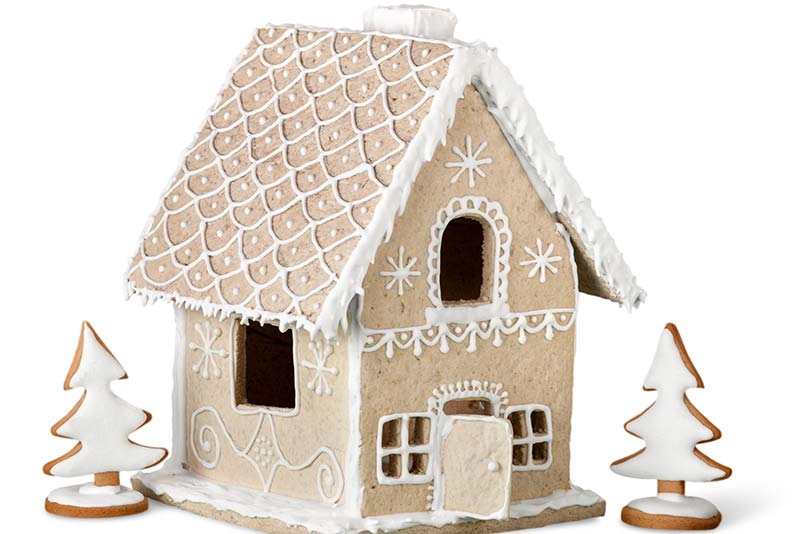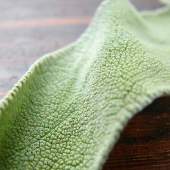Gingerbread

What food is a winter holiday mainstay, contains an ingredient with proven medicinal qualities, and is often used as a building material?
Gingerbread, that’s what. And given that next Tuesday is National Gingerbread House Day, this is a perfect opportunity to take a closer look at this delicious Christmas tradition that manages to be both a cure-all and a form of creative expression.
First, a little treatise on its namesake ingredient, the ginger root. Since its discovery in Asia at least 5,000 years ago, extract from this plant (Zingiber officinale) has been used as an herbal remedy for a wide variety of ailments: the common cold, migraines, arthritis, menstrual issues, nausea due to motion and morning sickness, and even hypertension. Ginger has been incorporated into recipes for almost that long, especially “honey cakes,” which go all the way back to ancient Rome.
How popular was ginger, and how did it become synonymous with Christmas? One theory (by no means the only one) originates with a medieval legend that expands upon the story of the Three Wise Men, who visited the baby Jesus with their offerings of gold, frankincense, and myrrh. According to the legend, there was meant to be a fourth magus who couldn’t make the trip; his gift was to be ginger root. This Fourth Wise Man later met a rabbi who told him of an ancient prophecy that Jesus would be born in Bethlehem, a city whose name means “house of bread” in Hebrew. Ever since the prophecy had come to pass, this rabbi had been advising his young students to make houses from bread as a tribute to the Messiah. The Fourth Wise Man suggested adding ground ginger to the bread to spice things up, and voila! Gingerbread houses were born.
Ginger
Nobody knows who baked the first “gingerbread-that-wasn’t-bread” as we know it today (called Lebkuchen), but the recipe for it may have been brought to France by an Armenian monk, Gregory of Nicopolis, in the year 992. That he later became a saint probably had nothing to do with gingerbread, but you never know.
As with many other foods, gingerbread became popular with the masses because it was easy and inexpensive to make, and almost impossible to ruin. Its most common sweetener was honey, but in the British Isles, molasses was an oft-used substitute. Common spices, in addition to the ginger, were (and still are) cardamom, anise, cinnamon, nutmeg, and cloves.
Over time, gingerbread evolved from a cake-like texture to more of a crisp, sturdy biscuit, and chefs quickly began coming up with elaborate things that could be made from them, along with innovative methods of realizing their artistic vision. The first record we have of gingerbread figures comes from the court of Elizabeth I, who charged her kitchen staff to create gingerbread likenesses of her most important guests, which must have impressed them to no end. Shortly after Elizabeth’s reign, Nuremberg, Germany began to be known as the “Gingerbread Capital of the World,” where baking guilds cropped up, composed of artisans and craftsmen devoted to dreaming up and engineering gingerbread works of art.
The first gingerbread houses as we think of them today may have come about as a response to the Grimm Brothers’ 1812 fairy tale Hansel and Gretel, about a brother and sister who, lost in a forest, come upon a charming gingerbread house decorated with candies. The evil, cannibalistic witch who lives there holds them captive and tries to eat them, but crafty Gretel shoves the witch screaming into a burning stove and she and Hansel steal all her money. Reunited with their father, the children live happily ever after. (Heartwarming, huh?) Some historians think that the Grimm Brothers based their story on a gingerbread tradition that was already in place, so it will probably always be a “which came first, the chicken or the egg?” dilemma. In any event, it’s fairly certain that it was German immigrants who brought the gingerbread house phenomenon to America, as they did with a variety of other culinary traditions, including the hamburger.
Fun facts about gingerbread and the structures made from it:
- The world’s largest gingerbread house to date was constructed in 2013 in Bryan, Texas to benefit a hospital trauma center. It boasted an area of 2,520 square feet and used almost 3,000 pounds of brown sugar, more than 7,000 eggs, 2,500 pounds of candy, and more than 7,000 pounds of flour. Calorie count: almost 36 million. You could even walk inside, in case that’s an item on your bucket list.
- Each year at Christmastime, the citizens of Bergen, Norway create an entire gingerbread village. In 2009, the citizens of Bergen were scandalized when a vandal destroyed it. Bah, humbug!
- Bergen, however, has nothing on a gingerbread city created by the culinary team at New York’s Marriott Marquis Hotel. The Guinness Book of World Records declared it the largest ever, with 157 businesses and homes, a working cable car system, and a train…all made of gingerbread.
- Generally speaking, the “glue” needed to hold the pieces of the gingerbread house together is made from meringue or royal icing. Decorations – and architectural touches – are limited only by your imagination, but hard candies, gumdrops, and candy canes are standard.
- Other building materials used as an alternative to gingerbread include graham crackers, waffle cones, sugar cubes, vegetables, crackers, chocolate bars, and pretzel rods (for a log cabin, of course).
- In England, unmarried women are encouraged to eat a gingerbread man if they want to attract a husband. Swedish tradition dictates that if you make a wish while holding a piece of gingerbread in one palm and manage to break it into exactly three pieces with your other hand, your wish will come true.
If you’re looking for a fun activity to do with children at Christmastime, decorating a gingerbread house just might fill the bill. And if they eat too much candy in the process, a little ginger tea will make it all better!





